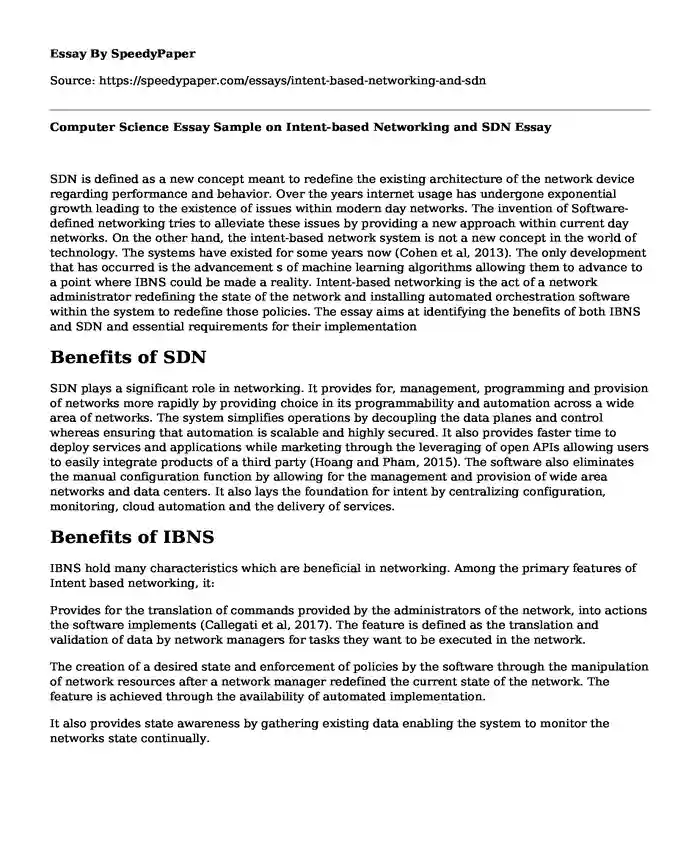
| Type of paper: | Essay |
| Categories: | Computer science |
| Pages: | 3 |
| Wordcount: | 705 words |
SDN is defined as a new concept meant to redefine the existing architecture of the network device regarding performance and behavior. Over the years internet usage has undergone exponential growth leading to the existence of issues within modern day networks. The invention of Software-defined networking tries to alleviate these issues by providing a new approach within current day networks. On the other hand, the intent-based network system is not a new concept in the world of technology. The systems have existed for some years now (Cohen et al, 2013). The only development that has occurred is the advancement s of machine learning algorithms allowing them to advance to a point where IBNS could be made a reality. Intent-based networking is the act of a network administrator redefining the state of the network and installing automated orchestration software within the system to redefine those policies. The essay aims at identifying the benefits of both IBNS and SDN and essential requirements for their implementation
Benefits of SDN
SDN plays a significant role in networking. It provides for, management, programming and provision of networks more rapidly by providing choice in its programmability and automation across a wide area of networks. The system simplifies operations by decoupling the data planes and control whereas ensuring that automation is scalable and highly secured. It also provides faster time to deploy services and applications while marketing through the leveraging of open APIs allowing users to easily integrate products of a third party (Hoang and Pham, 2015). The software also eliminates the manual configuration function by allowing for the management and provision of wide area networks and data centers. It also lays the foundation for intent by centralizing configuration, monitoring, cloud automation and the delivery of services.
Benefits of IBNS
IBNS hold many characteristics which are beneficial in networking. Among the primary features of Intent based networking, it:
Provides for the translation of commands provided by the administrators of the network, into actions the software implements (Callegati et al, 2017). The feature is defined as the translation and validation of data by network managers for tasks they want to be executed in the network.
The creation of a desired state and enforcement of policies by the software through the manipulation of network resources after a network manager redefined the current state of the network. The feature is achieved through the availability of automated implementation.
It also provides state awareness by gathering existing data enabling the system to monitor the networks state continually.
Cost-effectiveness of both systems in the IT environment
Virtualization requires that the CPU remains in a privileged state which if not maintained can be quite costly leading to the loss of CPU Caches and eviction of old entries. As a result, the organization is forced to adopt the Translation lookaside buffer which is quite costly. On the other hand, computing costs can become expensive when organizations try to move large volumes of data or store the data within the system for a long time (Schaller & Hood, 2017).
However, SDN and IBNS provide a whole new outlook in cost-effectiveness. Not only does the two provide improved management of networks, but they also offer for the existence of cost-effective networks. The architecture of SDN and IBNS will enable them to install network intelligence within the software reducing the need for buying expensive physical hardware. Both systems change the density and size of stored data allowing the company to lower costs and centralize visibility and management leading to the reduction of cost and complexity. Both systems build on each other making networking useful and predictive (Schaller & Hood, 2017)
References
Cohen, R., Barabash, K., Rochwerger, B., Schour, L., Crisan, D., Birke, R., ... & Jain, V. (2013, May). An intent-based approach for network virtualization. In Integrated Network Management (IM 2013), 2013 IFIP/IEEE International Symposium on (pp. 42-50). IEEE.
Schaller, S., & Hood, D. (2017). Software-defined networking architecture standardization. Computer Standards & Interfaces, 54, 197-202.
Hoang, D. B., & Pham, M. (2015, September). On software-defined networking and the design of SDN controllers. In Network of the Future (NOF), 2015 6th International Conference on the (pp. 1-3). IEEE.
Callegati, F., Cerroni, W., Contoli, C., & Foresta, F. (2017, May). Performance of intent-based virtualized network infrastructure management. In Communications (ICC), 2017 IEEE International Conference on (pp. 1-6). IEEE.
Cite this page
Computer Science Essay Sample on Intent-based Networking and SDN. (2022, Sep 28). Retrieved from https://speedypaper.com/essays/intent-based-networking-and-sdn
Request Removal
If you are the original author of this essay and no longer wish to have it published on the SpeedyPaper website, please click below to request its removal:
- Comparison Essay Sample: Marijuana and Alcohol
- Essay Sample: Assessment of Additive Manufacturing Technologies
- Essay Sample Discussing Racial Bias in the Judicial Process
- How the System of White Supremacy Works in the US Context? Free Essay Sample
- Italian Food Industry Review
- Essay Example on Ricin as Bioweapons
- Essay Sample on Preserving the Land
Popular categories




